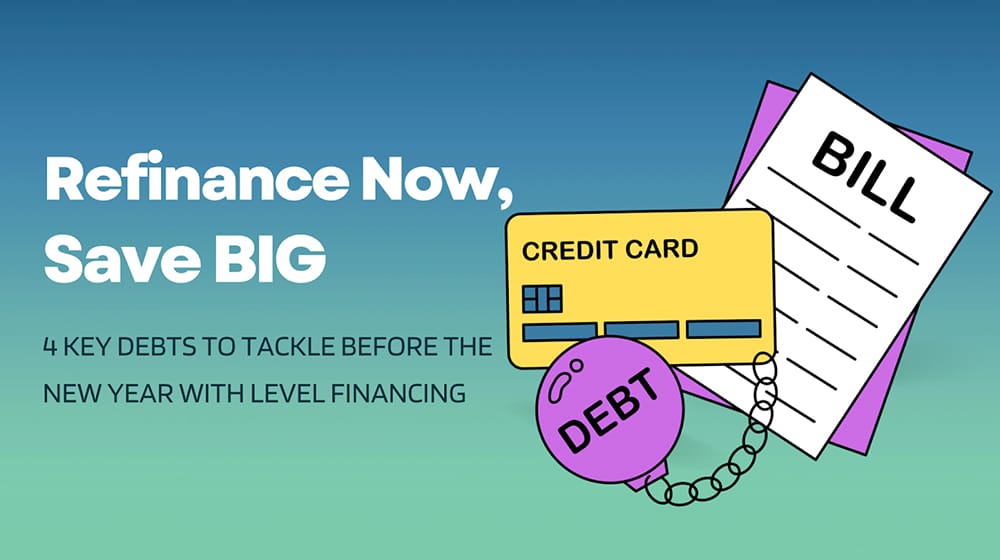Lenders use different criteria to determine a borrower’s eligibility for a loan. One of the most important ones is the debt-to-income ratio or DTI. Loan providers use it to assess your ability to make regular repayments based on your monthly income and current debt situation.
So what is the ideal debt-to-income ratio when applying for a loan? In this article, we will show you how to calculate it, which level of DTI is generally considered good by lenders, and what the best strategies are to bring it to a healthy level, as well as maintain it.
Calculating Your DTI
Your DTI is the percentage of your monthly income needed to cover your monthly debt obligations. Here is the basic formula.

Let’s imagine that your recurring monthly debt includes the following payments.
- Mortgage payment: $1,000
- Credit card payment: $600
- Car loan payment: $300
This means that your overall recurring monthly debt is $1,900. It is obtained by summing up your monthly debt obligations.
Now let’s assume that you have two part-time jobs: one working as a sales representative and the other working as a night school teacher. Here are your monthly salaries before contributions and taxes.
- Gross monthly salary for your first job: $4,000
- Gross monthly salary for your second job: $2,500
This means that your gross monthly income is $6500, which is obtained by summing the above values.
We can now go back to the initial formula and calculate your debt-to-income ratio.

This means that 29.23% of your gross monthly income is currently used to service your debt.

How Do Lenders Interpret Your DTI?
All other circumstances being equal, the lower your debt-to-income ratio, the higher the chance of seeing your loan application approved.
That’s because loan providers want to make sure that you have enough available income to make monthly debt repayments without putting excessive stress on your personal finances. If your current debt obligations eat away too much of your monthly earnings, lenders will see extending a loan to you as a risky business.
A lender’s evaluation may vary based on whether you are a homeowner or a renter. Here is some interesting data provided by the Consumer Financial Protection Bureau.
- Lenders want to see a DTI of 36% or less when homeowners apply for a loan (some may accept a DTI as high as 43%).
- If you are a renter, you should keep your DTI below 20% (or even better, below 15%). Please note that your rent payments are not a debt obligation and are not included in the calculation of your debt-to-income ratio.
Moreover, your current debt-to-income ratio may affect the amount you are allowed to borrow and not just the success of your loan application.
Read more: How Much Can I Borrow?
Mortgage Debt-to-Income Ratio
Mortgage providers won’t just look at your overall DTI. They will also analyze your DTI for mortgage debt alone. This is known as mortgage DTI. Here is the formula to calculate it.

In the above example:

In addition to maintaining your total DTI below 36%, it’s advisable to keep your mortgage DTI below 28% when applying for a mortgage loan.
Does Your DTI Affect Your Credit Score?
Credit agencies don’t look at your debt-to-income ratio, mostly because they don’t know how much you earn monthly. Therefore, your DTI doesn’t affect your FICO score. Other related factors may affect it, though. These include:
- the total debt you owe
- your payment history
- the length of your credit history
- your credit utilization ratio
- taking out new loans

How Do You Lower Your DTI and Keep it at a Good Level?
If you’re trying to reduce your DTI, there are various strategies that you can adopt.
Your debt-to-income ratio can be lowered by either reducing your monthly debt obligations or by increasing your monthly income. Depending on your current financial situation, you may try to reduce your DTI by
- mostly lowering your debt
- mostly increasing your income
- using a combination of both
Let’s explore these three options in further detail.
Reducing Your DTI by Lowering Your Total Debt
Let’s assume your current debt-to-income ratio is around 39%.
You earn $6,300 a month working full-time. Your total debt monthly obligations amount to $2,500 and are distributed as follows:
- mortgage payment: $1,400
- credit card payment: $700
- car loan payment: $400
There is currently no room to increase your monthly salary. Because you have a good FICO score, you find an online lender willing to offer a personal loan at very favorable conditions. You can use it to consolidate both your credit card debt and car loan over a longer period of time and at a more advantageous interest rate. This may significantly reduce your monthly debt obligations. For example, your new situation could be:
- mortgage payment: $1,400
- personal loan payment: $300
Your monthly debt obligations would now amount to $1,700, and your debt-to-income would only be 27%.
Alternative ways to reduce your monthly debt obligations include:
- paying back a significant share of the principal by selling valuable assets or accumulating enough savings
- enrolling in a debt resolution plan
- enrolling in a debt management plan
Reducing Your DTI by Increasing Your Income
In the previous example, let’s imagine that it’s possible to increase your monthly income. Here are some of the ways to achieve this.
- You can negotiate a salary increase with your employer.
- You can take a course to learn a new skill and get a better-paying job.
- You have time to start a second job.
- You can freelance in your spare time.
- You have a second apartment you can rent to a tenant.
Let’s say that by pursuing one or more of these options, you manage to increase your monthly income to $8000. This means that your debt-to-income ratio has gone down from 39% to around 31%.
Reducing Your DTI by Using a Combination of Both
Usually, the best way to go is using a mix of these two strategies. Why work with one hand when you have two at your disposal? Let’s say that you can lower your monthly debt obligation by $600 by cutting costs while, at the same time, you can negotiate a pay increase of $800 with your boss.
Your monthly debt obligations are now down to $1,900, while your gross monthly income is up to $7,100, meaning your debt-it-income ratio is now around 27%.
How to Keep my Debt-to-Income-Ratio Healthy?
Once you have managed to lower your debt-to-income ratio to a level that is acceptable to most lenders, it’s important to maintain it. Here are some useful tactics to follow to do so.
- Avoid taking out new loans before you have reduced your current debt by a similar amount.
- When possible, refinance your debt at a lower borrowing cost and with a longer repayment period.
- Keep learning new skills to qualify for pay increases or better jobs positions.
- Find a part-time job or a freelance gig to earn something on the side.
- Look for investments that provide a stable monthly return.





